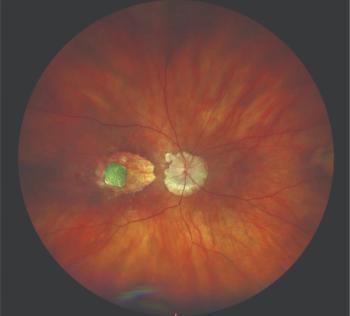
Integrin peptide for AMD emerging
In the first clinical trial of ALG-1001 in wet AMD, there was an apparent clinical benefit to patients, as evidenced by improvements from baseline visual acuity and macular anatomy.
Take-home
In the first clinical trial of ALG-1001 in wet AMD, there was an apparent clinical benefit to patients, as evidenced by improvements from baseline visual acuity and macular anatomy.
Seattle-Integrin peptide therapy is an emerging new class of treatment for neovascular eye diseases, including wet age-related macular degeneration (AMD).
In the first clinical trial of a synthetic anti-integrin oligopeptide (ALG-1001, Allegro Ophthalmics) in wet AMD, there was an apparent clinical benefit to patients, as evidenced by improvements from baseline visual acuity and macular anatomy, said study author Peter K. Kaiser MD, at the annual meeting of the Association for Research in Vision and Ophthalmology.
Dr. KaiserDespite the fact that this was a phase Ib trial with a small study cohort, the authors note that clinically relevant indicators of efficacy were demonstrated with improvements in best-corrected visual acuity (BCVA) alongside anatomic improvements in optical coherence tomography (OCT) central macular thickness (CMT). These improvements persisted for at least 60 days off-treatment after receiving three monthly loading doses.
“The study is . . . ongoing with a handful of study subjects still finishing . . . their last few visits,” said Dr. Kaiser, a staff member of the vitreoretinal faculty of the Cole Eye Institute, Department of Ophthalmology, Cleveland Clinic. “The improvements in BCVA and macular anatomy appear to hold past 3 months off-treatment.”
To date, the longest follow-up time is 5 months off-treatment. That was for one participant who returned a month late for the 4-month off-treatment visit.
“The study subject was still holding BCVA and anatomic improvements at 5 months off all treatment,” Dr. Kaiser said.
How it works
(Figure 1) Unlike monoclonal antibodies, ALG-1001 is a small oligopeptide capable of binding to multiple integrin receptor sites with a long-lasting effect. ALG-1001 interferes with several pathways of the angiogenic cascade, as it can bind to multiple integrin-receptor sites that are known to be involved in both choroidal and pre-retinal neovascularization. In vitro, ALG-1001 inhibits integrin receptors and in vivo, arrests aberrant blood vessel growth that is meditated by integrins αv β3, αvβ5, and α5β1. These are sites that are expressed in neovascular ocular tissue in wet AMD as well as diabetic retinopathy.
Experimental studies showed a statistically significant reduction in choroidal neovascularization (CNV), retinopathy of prematurity (ROP), and vascular permeability. A small phase I study in patients with diabetic macular edema showed that more than half of cohort (55%) improved 3 to 5 lines in BCVA, with at least a 30% reduction in OCT CMT with ALG-1001 monotherapy that held for at least 3 months off-treatment.
Phase Ib trial
In this phase Ib trial, Dr. Kaiser and colleagues evaluated the safety and dose ranging of intravitreal ALG-1001 in patients with CNV due to wet AMD. The primary endpoint of the study was to observe any dose limiting toxicity.
The key criteria for trial inclusion included a baseline BCVA between 20/50 and 20/320 and CNV due to AMD, and patients could not have received prior treatment with anti-vascular endothelial growth factor (VEGF) treatment within 45 days of enrollment. The 15 participants who have been in enrolled in the trial are a combination of treatment-naïve and previously treated patients.
All patients received a loading dose of three monthly intravitreal injections of either 2- or 3.2-mg ALG-1001 in monotherapy and were followed for an additional 4 months off-treatment.
Even though it was not the primary endpoint of the study, and the study continues to be ongoing, the authors observed that there was a clear improvement in BCVA and macular anatomy by OCT in about 50% of trial participants in the 3.2-mg dose group. These clinical benefits were long lasting and persisted for at least 60 days off-treatment, following a three-monthly-injection-loading dose.
(Figure 2) Working from a different mechanism of action from anti-vascular endothelial growth factor therapy, ALG-1001 targets key integrin-receptor sites implicated in proliferation and maturation of new blood vessels.
(Figure 3) A dose response curve shows patients in the 3.2-mg group responded with an average improvement of 8 letters, whereas there was a continued loss of vision on average with the 2-mg group. (Figures courtesy of Allegro Ophthalmics)There was a definite dose response curve between the 2- and the 3.2-mg doses, Dr. Kaiser noted.
“The higher 3.2-mg dose produced a robust clinical response/improvement,” he said. “The average improvement in ETDRS BCVA was +8 letters in the 3.2-mg dose at study day 120, which was 60 days off-treatment after the three monthly loading doses.”
In addition, the mean reduction in central macular thickness for group receiving 3.2 mg was 29.8% at study day 150, which was 90 days off-treatment after the three loading doses.
“And these results were for monotherapy with the ALG-1001 drug, not combination therapy,” Dr. Kaiser said.
Clinical benefits of ALG-1001 lasted for at least 60 days after treatment ended, but it is unknown how long patients would have to continue using the agent in order for benefits to continue. The exact duration of the clinical benefit is unknown at this time.
But based on these results, Dr. Kaiser believes that this is a promising new treatment for this patient population.
“We were very happy to see such a strong efficacy signal in a phase I, proof-of-concept study, with the clinical benefits holding on average out to at least 90 days off-treatment,” he said. “Given this drug’s different mechanism of action, over anti-VEGF and the early but robust efficacy signal generated in this study, it gives us hope that this drug will provide a new category of long-lasting drugs to treat the large patient population affected by wet AMD.”
The authors are planning a phase II U.S. study in wet AMD that will look at dose ranging, dosing regimens, and ALG-1001 used as monotherapy, and as part of combination therapy.
Peter K. Kaiser, MD
Dr. Kaiser did not indicate a proprietary interest in the subject matter. Allegro Ophthalmics is developing this compound.
Newsletter
Don’t miss out—get Ophthalmology Times updates on the latest clinical advancements and expert interviews, straight to your inbox.





